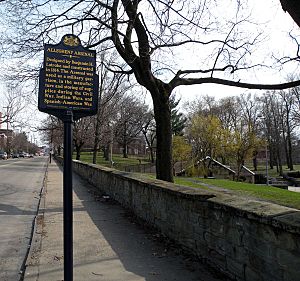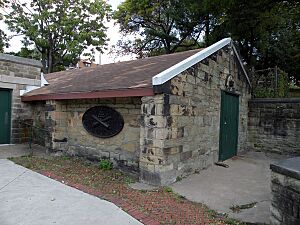Allegheny Arsenal facts for kids
|
Pennsylvania Historical Marker
|
|

The 40th Street side of the site of the former Allegheny Arsenal. The powder magazine can be seen on the right.
|
|
| Location | Arsenal Park, Lawrenceville, Pittsburgh, Pennsylvania |
|---|---|
| Coordinates | 40°28′00″N 79°57′40″W / 40.4666°N 79.9611°W |
| Area | 9 acres (3.6 ha) |
| Built/founded | 1814 |
| Architect | Benjamin Henry Latrobe? |
| Governing body/ |
City of Pittsburgh |
| PHMC dedicated | n/a |
| CPHD designated | February 22, 1977 |
| PHLF designated | 2003 |
The Allegheny Arsenal was a very important place during the American Civil War. It was built in 1814 and helped supply the Union Army with weapons and other items. Sadly, it was also the site of the biggest accident involving regular people during the war.
Today, this historic spot is a nine-acre park called Arsenal Park. You can find it in the Central Lawrenceville neighborhood of Pittsburgh, Pennsylvania.
In 2012, a group called the Pittsburgh History & Landmarks Foundation started to notice that the old arsenal buildings were falling apart. They wanted to help save these important structures.
Contents
What Was the Allegheny Arsenal?
The U.S. Army Ordnance Department built the Allegheny Arsenal in 1814. It was located near Pittsburgh on about 30 acres of land. This land was next to the Allegheny River in a town called Lawrenceville.
The arsenal was a key place for making and sending supplies to soldiers. These soldiers were fighting in the western parts of the country.
How the Arsenal Helped During the Civil War
The arsenal was busiest during the Civil War. Making cartridges (bullets) was a top priority. Before the war, about 308 people worked there. During the war, this number grew to over 1,100 workers!
One of the busiest places was the main lab. It had 158 workers, and most of them were women. They worked hard making cartridges for the soldiers.
The Big Explosion of 1862
On Wednesday, September 17, 1862, a terrible explosion happened at the arsenal. It was around 2:00 PM. The blast was so strong that it broke windows in nearby homes. People in Pittsburgh, over two miles away, could hear it!
When the first explosion happened, Colonel John Symington, the arsenal's commander, ran to the lab. As he got closer, he heard a second explosion, then a third. Firefighters and a bucket brigade worked hard to put out the flames. A volunteer fire company from Pittsburgh also came to help.
The Tragic Outcome
By the time the fire was out, the lab was completely destroyed. It was just a pile of smoldering rubble. A total of 78 workers died. Most of them were young women.
Fifty-four bodies could not be identified. They were buried together in a large grave at the nearby Allegheny Cemetery. Some of the young people who died included 15-year-old Catherine Burkhart and 17-year-old Margaret Turney. They both worked making ammunition.
What Caused the Explosion?
People had different ideas about what caused the explosion. Many thought a horse's metal shoe might have hit a spark. This spark could have lit loose gunpowder on the road near the lab. Then, the fire might have traveled to the porch and set off barrels of gunpowder.
A group called a coroner's jury looked into the accident. They said Colonel John Symington and his team were careless. They believed too much loose powder was left on the road.
The Army's Investigation
Later, the army held its own investigation. Many of the same people who spoke to the coroner's jury changed their stories. There were so many differences in what people said. Because of this, many of the first ideas about the explosion were proven wrong.
In the end, the army found Colonel Symington innocent. The court said that the exact cause of the explosion "could not be satisfactorily ascertained."
Colonel Symington himself thought the explosion might have happened when powder leaked from a barrel. Many witnesses agreed that leaking barrels were a problem. Alexander McBride, the lab's supervisor, had often complained about powder barrels from Dupont and Company. He said they had loose covers.
Symington wondered if the company was using old barrels more than once. But even with these ideas, the real cause of the explosion is still unknown. Colonel Symington retired the next year.
What Happened After the Explosion?
The terrible explosion at the Allegheny Arsenal happened on the same day as the Battle of Antietam. This big battle took place in Sharpsburg, Maryland. Because of the battle, the arsenal explosion didn't get as much attention.
Work at the arsenal continued, and a new lab was built the next year. After the Civil War, the Allegheny Arsenal was mostly used to store supplies. In the 1900s, most of the land was sold off.
Today, the exact spot where the explosion happened is a ballfield in Arsenal Park. The old powder magazine is still there, but it's now used as a maintenance shed for the park.
Images for kids
-
Arsenal Park, part of the former arsenal site, including the surviving powder magazine (right), stone wall, and Pennsylvania state historical marker





